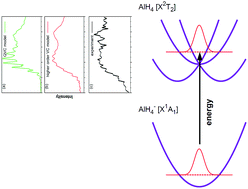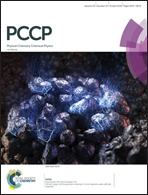On the higher-order T2 ⊗ (e + t2) Jahn–Teller coupling effects in the photodetachment spectrum of the alanate anion (AlH4−)†
Abstract
The static and dynamic aspects of the T2 ⊗ (e + t2) Jahn–Teller coupling effects in the ![[X with combining tilde]](https://www.rsc.org/images/entities/char_0058_0303.gif) 2T2 electronic state of the AlH4 radical are investigated theoretically by probing the first photodetachment spectrum of AlH4−. Associated potential energy surfaces up to two-dimensional space of nuclear coordinates are established from extensive electronic structure calculations and nuclear dynamics calculations are done on them via wave packet propagation including the nonadiabatic coupling of the three electronic sheets. The theoretical results are in good agreement with experimental observations. The present study established that the higher-order JT coupling terms (beyond the second order terms, which is considered to be standard JT theory) are important to correctly reproduce the spectral intensity and diffused vibrational structure of the
2T2 electronic state of the AlH4 radical are investigated theoretically by probing the first photodetachment spectrum of AlH4−. Associated potential energy surfaces up to two-dimensional space of nuclear coordinates are established from extensive electronic structure calculations and nuclear dynamics calculations are done on them via wave packet propagation including the nonadiabatic coupling of the three electronic sheets. The theoretical results are in good agreement with experimental observations. The present study established that the higher-order JT coupling terms (beyond the second order terms, which is considered to be standard JT theory) are important to correctly reproduce the spectral intensity and diffused vibrational structure of the ![[X with combining tilde]](https://www.rsc.org/images/entities/char_0058_0303.gif) 2T2 electronic state of AlH4. More specifically, we found that expansions of the JT coupling parameters up to the fourth order of the nuclear coordinates are necessary for a reliable description of the JT effect in this electronic manifold. Various static aspects of the JT coupling effects and vibrational progressions under the complex and highly irregular
2T2 electronic state of AlH4. More specifically, we found that expansions of the JT coupling parameters up to the fourth order of the nuclear coordinates are necessary for a reliable description of the JT effect in this electronic manifold. Various static aspects of the JT coupling effects and vibrational progressions under the complex and highly irregular ![[X with combining tilde]](https://www.rsc.org/images/entities/char_0058_0303.gif) 2T2 vibronic band of the AlH4 radical are examined in detail.
2T2 vibronic band of the AlH4 radical are examined in detail.



 Please wait while we load your content...
Please wait while we load your content...